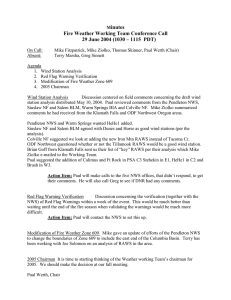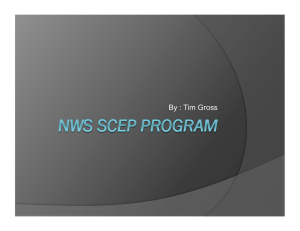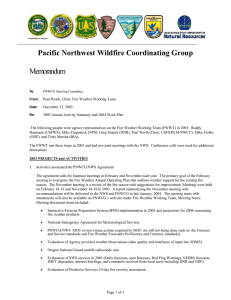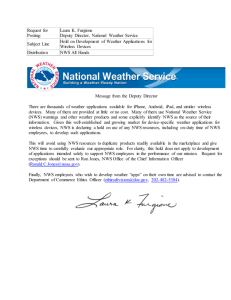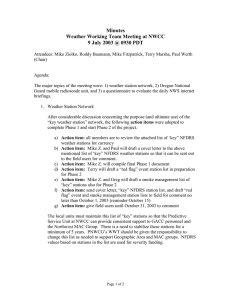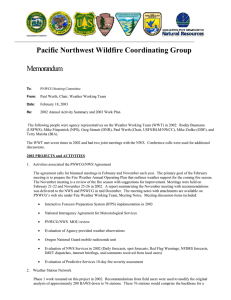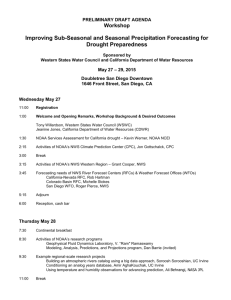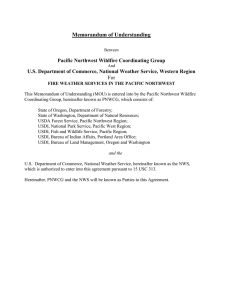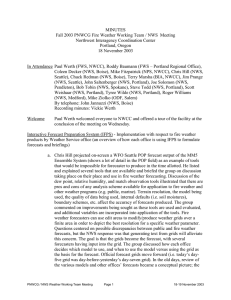Spring 2003 Weather Working Team/National Weather Service Meeting
advertisement
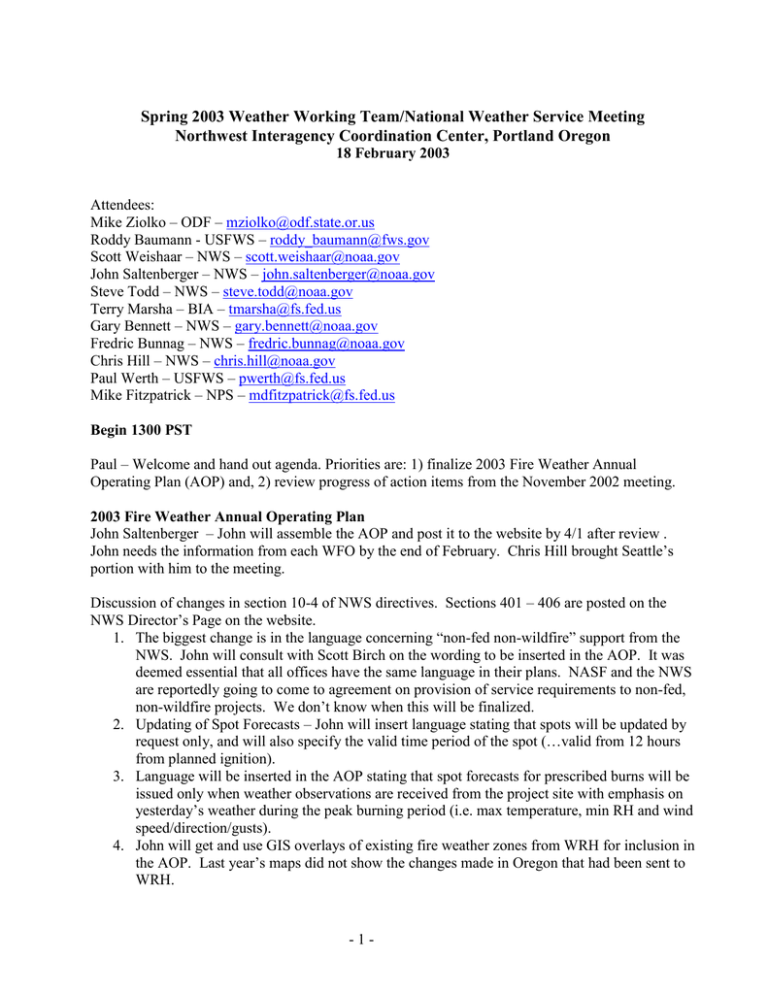
Spring 2003 Weather Working Team/National Weather Service Meeting Northwest Interagency Coordination Center, Portland Oregon 18 February 2003 Attendees: Mike Ziolko – ODF – mziolko@odf.state.or.us Roddy Baumann - USFWS – roddy_baumann@fws.gov Scott Weishaar – NWS – scott.weishaar@noaa.gov John Saltenberger – NWS – john.saltenberger@noaa.gov Steve Todd – NWS – steve.todd@noaa.gov Terry Marsha – BIA – tmarsha@fs.fed.us Gary Bennett – NWS – gary.bennett@noaa.gov Fredric Bunnag – NWS – fredric.bunnag@noaa.gov Chris Hill – NWS – chris.hill@noaa.gov Paul Werth – USFWS – pwerth@fs.fed.us Mike Fitzpatrick – NPS – mdfitzpatrick@fs.fed.us Begin 1300 PST Paul – Welcome and hand out agenda. Priorities are: 1) finalize 2003 Fire Weather Annual Operating Plan (AOP) and, 2) review progress of action items from the November 2002 meeting. 2003 Fire Weather Annual Operating Plan John Saltenberger – John will assemble the AOP and post it to the website by 4/1 after review . John needs the information from each WFO by the end of February. Chris Hill brought Seattle’s portion with him to the meeting. Discussion of changes in section 10-4 of NWS directives. Sections 401 – 406 are posted on the NWS Director’s Page on the website. 1. The biggest change is in the language concerning “non-fed non-wildfire” support from the NWS. John will consult with Scott Birch on the wording to be inserted in the AOP. It was deemed essential that all offices have the same language in their plans. NASF and the NWS are reportedly going to come to agreement on provision of service requirements to non-fed, non-wildfire projects. We don’t know when this will be finalized. 2. Updating of Spot Forecasts – John will insert language stating that spots will be updated by request only, and will also specify the valid time period of the spot (…valid from 12 hours from planned ignition). 3. Language will be inserted in the AOP stating that spot forecasts for prescribed burns will be issued only when weather observations are received from the project site with emphasis on yesterday’s weather during the peak burning period (i.e. max temperature, min RH and wind speed/direction/gusts). 4. John will get and use GIS overlays of existing fire weather zones from WRH for inclusion in the AOP. Last year’s maps did not show the changes made in Oregon that had been sent to WRH. -1- 5. All RAWS locations in the AOP will be listed with a degree, minute, second format (i.e. 121o 45’ 30”). No decimals. Action Items 1. Oregon National Guard Mobile Radiosonde Unit – Protocols for the use of this unit will be put into “Ops Plan Smokey” (operating plan used by ONG and ODF to deploy resources on wildfires). This unit will be available for use on wildfires this fire season, but only available on fires in Oregon. Chris Hill will check into the availability of a similar unit in Washington. Criteria for deployment will include fires burning in areas not covered by an existing radiosonde stations, long duration fires burning in a timber environment, and the discretion of the coordinators at NWCC and ODF with input from the Predictive Services and NWS fire weather personnel. 2. RAWS evaluation for IFPS. Paul distributed a list of 15 stations that he had given previously to Sue Ferguson for use in the MM5 model. After discussion, minor changes were made to the list: replacing Hurricane with Ellis Mtn in northwest Washington, adding Calimus Butte in south-central Oregon and deleting HeHe #1 in central Oregon. The Lat/Lon at each site needs to be validated. Each WFO will produce forecasts for the RAWS within their area and post in table format to the web. Predictive Services at NWCC will evaluate the hourly temp, RH and wind speed forecasts for the next 24 hour period with the observed weather from each RAWS. The goal is to determine the accuracy of ISFPS and MM5 forecasts with respect to diurnal and major weather pattern changes. 3. A questionnaire to evaluate daily NWS Internet briefings will be developed by June 1. It will be patterned after an existing questionnaire used by Medford to poll their local users on the usefulness of these briefings. The questionnaire will be posted on each WFO’s web page and also circulated by NWCC Predictive Services to local units within the Northwest Geographic Area in late July and late August. 4. IMET dispatch procedures will be reviewed for consistency in the existing MOB guides. 5. Predictive Services fire weather meteorologists will develop procedures for moderating the daily conference call between NWS and GACC meteorologists prior to June 1. The Fall meeting is scheduled for November 18-19, 2003 at the Northwest Interagency Coordination Center in Portland. Adjourn at 1645 PST -2-
